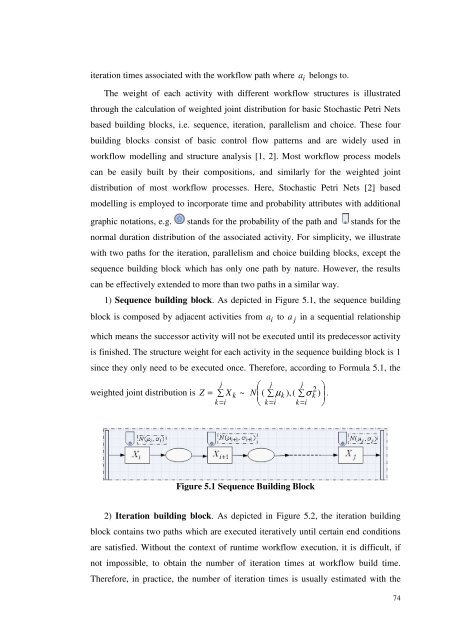Xiao Liu PhD Thesis.pdf - Faculty of Information and Communication ...
Xiao Liu PhD Thesis.pdf - Faculty of Information and Communication ...
Xiao Liu PhD Thesis.pdf - Faculty of Information and Communication ...
Create successful ePaper yourself
Turn your PDF publications into a flip-book with our unique Google optimized e-Paper software.
iteration times associated with the workflow path where a i belongs to.<br />
The weight <strong>of</strong> each activity with different workflow structures is illustrated<br />
through the calculation <strong>of</strong> weighted joint distribution for basic Stochastic Petri Nets<br />
based building blocks, i.e. sequence, iteration, parallelism <strong>and</strong> choice. These four<br />
building blocks consist <strong>of</strong> basic control flow patterns <strong>and</strong> are widely used in<br />
workflow modelling <strong>and</strong> structure analysis [1, 2]. Most workflow process models<br />
can be easily built by their compositions, <strong>and</strong> similarly for the weighted joint<br />
distribution <strong>of</strong> most workflow processes. Here, Stochastic Petri Nets [2] based<br />
modelling is employed to incorporate time <strong>and</strong> probability attributes with additional<br />
graphic notations, e.g. st<strong>and</strong>s for the probability <strong>of</strong> the path <strong>and</strong> st<strong>and</strong>s for the<br />
normal duration distribution <strong>of</strong> the associated activity. For simplicity, we illustrate<br />
with two paths for the iteration, parallelism <strong>and</strong> choice building blocks, except the<br />
sequence building block which has only one path by nature. However, the results<br />
can be effectively extended to more than two paths in a similar way.<br />
1) Sequence building block. As depicted in Figure 5.1, the sequence building<br />
block is composed by adjacent activities from a i to<br />
a j in a sequential relationship<br />
which means the successor activity will not be executed until its predecessor activity<br />
is finished. The structure weight for each activity in the sequence building block is 1<br />
since they only need to be executed once. Therefore, according to Formula 5.1, the<br />
j<br />
weighted joint distribution is Z = ∑ X k ~<br />
k = i<br />
⎛ j<br />
N⎜<br />
( ∑<br />
⎝ k = i<br />
j<br />
2 ⎞<br />
k ),( ∑σ<br />
k ) ⎟<br />
k = i ⎠<br />
µ .<br />
Figure 5.1 Sequence Building Block<br />
2) Iteration building block. As depicted in Figure 5.2, the iteration building<br />
block contains two paths which are executed iteratively until certain end conditions<br />
are satisfied. Without the context <strong>of</strong> runtime workflow execution, it is difficult, if<br />
not impossible, to obtain the number <strong>of</strong> iteration times at workflow build time.<br />
Therefore, in practice, the number <strong>of</strong> iteration times is usually estimated with the<br />
74
















